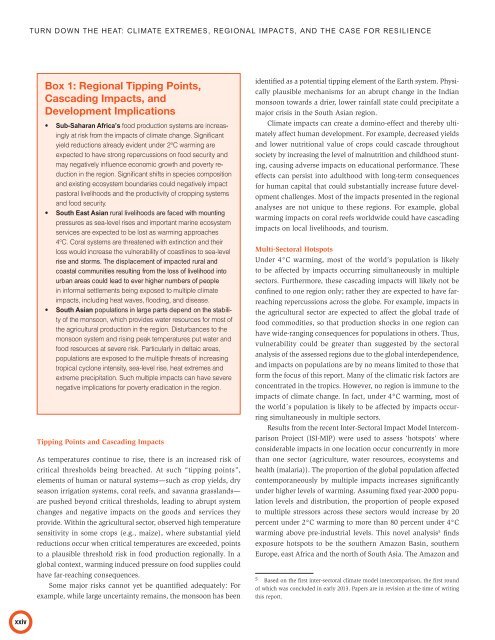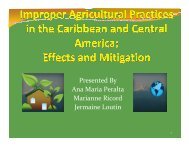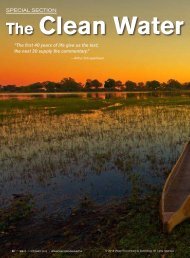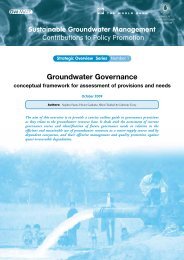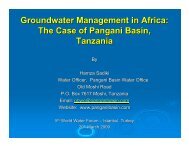You also want an ePaper? Increase the reach of your titles
YUMPU automatically turns print PDFs into web optimized ePapers that Google loves.
TURN DOWN THE HEAT: CLIMATE EXTREMES, REGIONAL IMPACTS, AND THE CASE FOR RESILIENCEBox 1: Regional Tipping Points,Cascading Impacts, andDevelopment ImplicationsSub-Saharan Africa’s--South East Asian rural livelihoods are faced with mountingrise and storms. The displacement of impacted rural andcoastal communities resulting from the loss of livelihood intourban areas could lead to ever higher numbers of peopleSouth Asian populations in large parts depend on the stabili-Tipping Points and Cascading ImpactsAs temperatures continue to rise, there is an increased risk ofcritical thresholds being breached. At such “tipping points”,elements of human or natural systems—such as crop yields, dryseason irrigation systems, coral reefs, and savanna grasslands—are pushed beyond critical thresholds, leading to abrupt systemchanges and negative impacts on the goods and services theyprovide. Within the agricultural sector, observed high temperaturesensitivity in some crops (e.g., maize), where substantial yieldreductions occur when critical temperatures are exceeded, pointsto a plausible threshold risk in food production regionally. In aglobal context, warming induced pressure on food supplies couldhave far-reaching consequences.Some major risks cannot yet be quantified adequately: Forexample, while large uncertainty remains, the monsoon has beenidentified as a potential tipping element of the Earth system. Physicallyplausible mechanisms for an abrupt change in the Indianmonsoon towards a drier, lower rainfall state could precipitate amajor crisis in the South Asian region.Climate impacts can create a domino-effect and thereby ultimatelyaffect human development. For example, decreased yieldsand lower nutritional value of crops could cascade throughoutsociety by increasing the level of malnutrition and childhood stunting,causing adverse impacts on educational performance. Theseeffects can persist into adulthood with long-term consequencesfor human capital that could substantially increase future developmentchallenges. Most of the impacts presented in the regionalanalyses are not unique to these regions. For example, globalwarming impacts on coral reefs worldwide could have cascadingimpacts on local livelihoods, and tourism.Multi-Sectoral HotspotsUnder 4°C warming, most of the world’s population is likelyto be affected by impacts occurring simultaneously in multiplesectors. Furthermore, these cascading impacts will likely not beconfined to one region only; rather they are expected to have farreachingrepercussions across the globe. For example, impacts inthe agricultural sector are expected to affect the global trade offood commodities, so that production shocks in one region canhave wide-ranging consequences for populations in others. Thus,vulnerability could be greater than suggested by the sectoralanalysis of the assessed regions due to the global interdependence,and impacts on populations are by no means limited to those thatform the focus of this report. Many of the climatic risk factors areconcentrated in the tropics. However, no region is immune to theimpacts of climate change. In fact, under 4°C warming, most ofthe world´s population is likely to be affected by impacts occurringsimultaneously in multiple sectors.Results from the recent Inter-Sectoral Impact Model IntercomparisonProject (ISI-MIP) were used to assess ‘hotspots’ whereconsiderable impacts in one location occur concurrently in morethan one sector (agriculture, water resources, ecosystems andhealth (malaria)). The proportion of the global population affectedcontemporaneously by multiple impacts increases significantlyunder higher levels of warming. Assuming fixed year-2000 populationlevels and distribution, the proportion of people exposedto multiple stressors across these sectors would increase by 20percent under 2°C warming to more than 80 percent under 4°Cwarming above pre-industrial levels. This novel analysis 5 findsexposure hotspots to be the southern Amazon Basin, southernEurope, east Africa and the north of South Asia. The Amazon and5 Based on the first inter-sectoral climate model intercomparison, the first roundof which was concluded in early 2013. Papers are in revision at the time of writingthis report.


